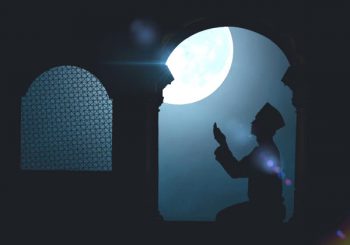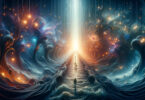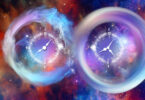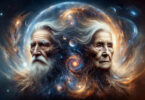By Santoshan (Stephen Wollaston)
Guest Writer for Wake Up World
The Qur’an, which literally means ‘the recital’, is held to be the direct word of God by Muslims and is the most sacred book of the Islamic faith. It is said to have been revealed by the angel Gabriel to the Prophet Muhammad while in various meditative trance-like states over a period of approximately 20 years, until the latter part of his life. The official Islamic accounts of Muhammad’s life (570-632 CE) say that he first encountered this experience in the 7th century CE when he was about 40 years old while meditating in a cave on the outskirts of Makkah. The Qur’an itself is looked upon by Muslims as a word for word translation of a tablet that is eternally preserved in heaven.
The Qur’an does not use the word miracle but instead mentions the Arabic word ayat, meaning ‘signs’. The Qur’an is in fact considered to have been created in a miraculous way – as a divine revelation. Because of this, it is referred to and looked upon as a miracle itself. Some Muslims have claimed that the Prophet Muhammad was actually illiterate and that this adds more weight to the claim of their principal Holy Book being a miracle. Even if man and jinn, a fiery spirit personality in Islam that is believed to be a separate species to angels and humans, banded together to try to produce it they would not be able to, the Qur’an tells us (17:90).
Although the Qur’an is seen as the principal miracle that happened in the life of the Prophet, various Hadiths, which contain his sayings and numerous legends about him, attribute many other miracles to him such as splitting the moon on one occasion when the people of Makkah requested to see a miracle. It seems like a particularly improbable claim if taken literally and was not reported to have been seen anywhere else in the world, which would be expected if such an event had happened, though it has a certain amount of charm about it. Yet it is surprisingly similar to a passage found in Buddhist scriptures about internal unity, which mentions how, ‘A monk who is skilled in concentration can cut the Himalayas in two’ (Anguttara Nikaya 6:24).
There are accounts of the Prophet multiplying water and food on different occasions. Once there was not enough water for ritual washing before prayer time. Muhammad put his hand inside a vessel that contained only a small amount of water and then spread out his fingers. Water then gushed out like a fountain for everyone to use. There are other miracles and miraculous events that are said to have happened around Muhammad and performed by him such as the restoring of a blind man’s sight, and rocks and mountains being heard to speak and pay tribute to Muhammad.
But it is perhaps the Prophet’s miraculous night journey, the miraj, that is the most fascinating. Sura/section 17.1 in the Qur’an mentions how he was transported from the town of Makkah to the furthest place of worship and was shown various signs. Different Hadiths mention how Muhammad was taken to Jerusalem where he then ascended to heaven accompanied by the angel Gabriel. There he conversed with Moses, saw various other prophets such as Jesus and Abraham, and was given the obligatory prayers for the followers of the faith. Afterwards, he was then taken back to Makkah. The famous Dome of the Rock in Jerusalem is said to mark the exact spot where he ascended to heaven. Scholars and Muslims alike have adopted different standpoints about this significant event. Some have interpreted it as a dream that the Prophet had, while others believe it was actually his physical body or at the very least his spirit body that was transported to both Jerusalem and heaven. Michael Muhammad Knight believes that,
The ascension not only stakes an Islamic claim over other traditions, but also becomes a template for any mystic’s journey, telling us about the capacity for all humans to embark on quests for transcendent encounters and advanced knowledge … In Sufi traditions, we find visionaries giving accounts of their own ascensions, recalling the various angelic, prophetic, or even divine figures with whom they interacted and the special secrets that they brought back to humankind.
In considering the overall teachings of the Qur’an we ought to remember that they are not trying to promote a new religion but are looked upon by Muslims as a continuation of the older Judeo-Christian tradition. The teachings accept the Torah, the Gospels, the early Jewish prophets and Jesus as early revelation, although they attempt to undermine further prophetic insights by claiming Muhammad to be ‘the Seal of the Prophets’ (33:40), the last in the line of prophets linking with the Bible. But some Islamic scholars such as Wilfred Madelung thought that the meaning of the term was not so certain.
Even within the Islamic tradition there has been some careful wordplay used to subtly attempt to steer around the statement and what it is thought to imply, which can be seen in an idea about ‘the Seal of the Saints’ put forward by Ibn ‘Arabi (1165-1240 CE), one of Sufism’s – the main mystical branch of Islam – greatest teachers, in which he sees himself as being the last to receive esoteric teachings because of his spirit being identical with Muhammad’s. But this idea actually contradicts ‘Arabi’s own teachings about One Essence, in which everyone’s spirit is seen as identical and, therefore, there should be no reason why ‘Arabi’s spirit would be more special than or favoured over anyone else’s.
Another important Sufi was Hallaj who was executed in Baghdad in 922 CE. He was associated with numerous miraculous abilities. He studied with the renowned Sufi Junayd in Iraq but broke away after a quarrel about following the path of the heart (called the Drunken School in Sufism) rather than the head (the Sober School) and later became a popular figure in Iran. He personally preferred to follow the path of devotion to God. He stopped wearing the woollen garment of the early Sufis and began to preach in public, as well as travel to places such as India and Central Asia.
He was eventually accused of performing magic and miracles and was arrested and thrown into prison. It is said that some accused him of blasphemy and others accused him of being a secret Christian. Some lesser open-minded Sufis accused him of believing that both human and divine nature could be harmonised. In addition to this, others felt that an idea he held about incarnation was not acceptable, as it implied having two separate essences that could be united. For if you are already God in essence, which some of his sayings appear to have suggested, then you cannot become what you already are.
The main reason for his execution it seems was more to do with his teaching that the pilgrimage to Makkah could be done in one’s own home and shows a lack of tolerance for different views and freethinking starting to enter the Islamic faith. His execution sent shockwaves through the Sufi tradition and put many of them on their guard. According to reports, the miracles were genuine and ranged from apporting fruit to making his whole body fill an entire room. Similar to Jesus, a popular saying of his was, ‘I am the Truth, I am the Real’, which draws on a famous saying in Islam. The divine is often referred to as ‘the Real’ in Sufism. In many ways Hallaj exemplified the deepest possibilities of personal piety to be found in Islam. He demonstrated the true meaning of submission to the unity of the divine – not with the aim of gaining any form of personal sanctity, but in order to live and teach the deeper mysteries of an authentic devotional life.
In the biographies of Islamic saints and mystics, there are accounts of both men and women who penetrated divine truths through their devotion to a spiritual way of life and living. The many miracles that have been credited to them are a part of mainstream Islamic belief. The Aqida Tahawi, which is a summary of Sunni beliefs, mentions the marvels of the saints and affirms the stories about them. Similar to the powers of Jesus and various yogis, their saints are credited with being able to fly, walk on water, foretell the future and travel hundreds of miles in one step.
In modern times we could draw upon one of the world’s leading exponents of Islamic science and spirituality, Seyyed Hossein Nasr, who points out that Oneness is the highest of all experience and gifts, and how in its ultimate sense this belongs only to God as the absolute, which he universally describes as Brahman, Allah, the Godhead and as the highest and ultimate reality. His writings on Sufism have a contemporary feel about them, are all-embracing and focus on a profound spirituality that is about how it is only the Spirit that is able to bring about an integration and unity of the psyche, intellect and mind. This implies both a vertical transcendence in order to discover the divine and an embodiment of it that horizontally embraces divinity in our lives and exhibits natural acts of compassion as a result of this discovery:
The supreme formula for unity in Islam is that ‘There is no Divinity but God’. That the Divine is all, in all and transcends all. The ultimate practice for Sufi’s is not to pray at all times, but for one’s life to become a constant act of prayer. For God is always present in all things.
– Seyyed Hossein Nasr
* * *
References:
- Affifi, AE, The Mystical Philosophy of Mhyid Din-Ibnul ‘Arabi, SH Muhammad Ashraf, Lahore, 1979.
- Arberry, Arthur J (translator), The Koran, Oxford University Press, Oxford, 1983 (reprint).
- — , Sufism: An Account of the Mystics of Islam, Unwin Paperbacks, London, 1979.
- Baldick, Julian, Mystical Islam: An Introduction to Sufism, IB Tauris and Co. Ltd, London, 1992 (reprint).
- Knight, Michael Muhammad, Muhammad: Forty Introductions, Soft Skull, New York, 2019.
- Nasr, Seyyed Hossein, Sufism and the Integration of the Inner and Outer Life of Man, Temenos Academy, London 1999.
- Schimmel, Annemarie, Mystical Dimensions of Islam, The University of North Carolina Press, Chapel Hill, 1978 (3rd edition).
- Waida, Manabu, Miracles, article in The Encyclopedia of Religion: Vol. 9 (edited by Mircea Eliade), Macmillan, New York and London, 1987.
Recommended Articles by Santoshan:
- Awakening to Creative Life
- Islamic Environmentalism
- Nature Mysticism: A Postmodern and Age-old Wisdom of the Heart
- Caring for Our Sacred Earth
About the author:
 This article is from the author’s book ‘Realms of Wondrous Gifts: Psychic, Mediumistic and Miraculous Powers in the Great Mystical and Wisdom Traditions’, which presents an in-depth look at psychic, mediumistic and miraculous powers in the world’s great mystical and wisdom traditions, and includes key insights into various teachings and practices. It also has two in-depth Q&A appendices with the late UK medium and former Benedictine monk Glyn Edwards, who was a close friend of the author for 26 years.
This article is from the author’s book ‘Realms of Wondrous Gifts: Psychic, Mediumistic and Miraculous Powers in the Great Mystical and Wisdom Traditions’, which presents an in-depth look at psychic, mediumistic and miraculous powers in the world’s great mystical and wisdom traditions, and includes key insights into various teachings and practices. It also has two in-depth Q&A appendices with the late UK medium and former Benedictine monk Glyn Edwards, who was a close friend of the author for 26 years.
Available as a low-cost paperback and eBook for Kindle from Amazon: https://www.amazon.co.uk/Realms-Wondrous-Gifts-Mediumistic-Miraculous/dp/1658935632/
And as a FREE eBook from Smashwords: https://www.smashwords.com/books/view/129418
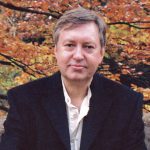 Stephen is an ordained interfaith minister and was given the name Santoshan (contentment) by an English swami in the mid-90s. In his early 20s, he was the principal bass guitarist of one of London’s first punk rock bands, The Wasps. He has studied transpersonal psychology, typographic design, and holds a degree in religious studies and a postgraduate certificate in religious education from King’s College London. He has served as a trustee of the UK charity GreenSpirit (www.greenspirit.org.uk) for many years, is a member of GreenSpirit’s editorial and publications committee, and the designer of GreenSpirit magazine. He was also a long-time close friend of the late UK medium and former Benedictine monk Glyn Edwards, co-authored his first two books with him and edited anthologies of his wisdom.
Stephen is an ordained interfaith minister and was given the name Santoshan (contentment) by an English swami in the mid-90s. In his early 20s, he was the principal bass guitarist of one of London’s first punk rock bands, The Wasps. He has studied transpersonal psychology, typographic design, and holds a degree in religious studies and a postgraduate certificate in religious education from King’s College London. He has served as a trustee of the UK charity GreenSpirit (www.greenspirit.org.uk) for many years, is a member of GreenSpirit’s editorial and publications committee, and the designer of GreenSpirit magazine. He was also a long-time close friend of the late UK medium and former Benedictine monk Glyn Edwards, co-authored his first two books with him and edited anthologies of his wisdom.
In all, Stephen/Santoshan has authored, co-authored and edited over twelve books, including ‘The House of Wisdom: Yoga Spirituality of the East and West’; ‘Spirituality Unveiled: Awakening to Creative Life’; ‘Rivers of Green Wisdom: Exploring Christian and Yogic Earth Centred Spirituality’; ‘Realms of Wondrous Gifts: Psychic, Mediumistic and Miraculous Powers in the Great Mystical and Wisdom Traditions’; and the multi-authored ‘Pathways of Green Wisdom: Discovering Earth Centred Teachings in Spiritual and Religious Traditions’ (GreenSpirit). See his Facebook page for more details: www.facebook.com/stevewollastonsantoshan/

If you've ever found value in our articles, we'd greatly appreciate your support by purchasing Mindful Meditation Techniques for Kids - A Practical Guide for Adults to Empower Kids with the Gift of Inner Peace and Resilience for Life.
In the spirit of mindfulness, we encourage you to choose the paperback version. Delve into its pages away from screen glare and notifications, allowing yourself to fully immerse in the transformative practices within. The physical book enriches the learning process and serves as a tangible commitment to mindfulness, easily shared among family and friends.
Over the past few years, Wake Up World has faced significant online censorship, impacting our financial ability to stay online. Instead of soliciting donations, we're exploring win-win solutions with our readers to remain financially viable. Moving into book publishing, we hope to secure ongoing funds to continue our mission. With over 8,500 articles published in the past 13 years, we are committed to keeping our content free and accessible to everyone, without resorting to a paywall.

